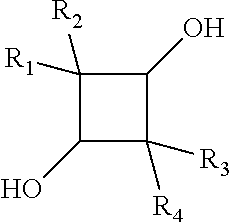Carboxyl functional curable polyesters containing tetra-alkyl cyclobutanediol
- Summary
- Abstract
- Description
- Claims
- Application Information
AI Technical Summary
Benefits of technology
Problems solved by technology
Method used
Image
Examples
example 1
Synthesis of Carboxyl-Functional TMCD-Based Polyester Using CHDA and IPA as the Diacids with AN:OH Ratio of at Least 0.5:1 (Resin 1)
[0170]A 500 mL, three-neck, round-bottom flask was equipped with a mechanical stirrer, a heated partial condenser, a Dean-Stark trap, and a water condenser. To the flask were charged 2,2,4,4-tetramethyl-13-cyclobutanediol (TMCD) (62.5 g); trimethylolpropane (TMP) (5.95 g); 1,4-cyclohexanedicarboxylic acid (CHDA) (34.4 g), isophthalic acid (IPA) (33.2 g), and the acid catalyst, Fascat-4100 (Arkema Inc.) (0.20 g). The reaction was allowed to react under nitrogen at 180° C. for 20 min., at 200° C. for 60 min., at 220° C. for 120 min., and at 230° C. for about 2 hours to yield a clear, viscous mixture. A total of 12.5 mL of distillate was collected in the Dean-Stark trap.
[0171]The reaction mixture was then allowed to cool to 150° C., followed by the addition of trimellitic anhydride (TMA) (14.06 g). After the addition of TMA, the temperature was increased t...
example 3
Synthesis of Carboxyl-Functional TMCD-Based Polyester Using CHDA and AD as the Diacids with an AN:OH of at Least 0.5:1 (Resin 15)
[0176]A 500 mL, three-neck, round-bottom flask was equipped with a mechanical stirrer, a heated partial condenser, a Dean-Stark trap, and a water condenser. To the flask were charged 2,2,4,4-tetramethyl-13-cyclobutanediol (TMCD) (65.0 g); trimethylolpropane (TMP) (6.19 g); 1,4-cyclohexanedicarboxylic acid (CHDA) (48.2 g), adipic acid (AD) (17.5 g), and the acid catalyst, Fascat-4100 (Arkema Inc.) (0.21 g). The reaction was allowed to react under nitrogen at 180° C. for 50 min., at 200° C. for 60 min., at 220° C. for 80 min., and at 230° C. for about 2 hours to yield a clear, viscous mixture. A total of 12 mL of distillate was collected in the Dean-Stark trap.
[0177]The reaction mixture was then allowed to cool to 150° C., followed by the addition of trimellitic anhydride (TMA) (14.06 g). After the addition of TMA, the temperature was increased to 170° C. an...
example 4
Preparation of Aqueous Dispersions of Various Polyesters
[0178]Below is a typical procedure for the preparation of aqueous dispersions of the polyesters synthesized.
[0179]A Parr reactor was used for the preparation of the resin dispersion. Resin 1 was first ground to about 6 mm pellets. The resin pellets (42.0 g) were then placed in the reaction vessel along with distilled water (78.0 g) and dimethylethanolamine (DMEA) (7.36 g) for neutralization. The amount of DMEA added for neutralization (100%) is calculated according to the measured acid number of the resin. The Parr reactor was then assembled and heated first to 95° C. and then to 110° C. The stirring was allowed to continue at 110° C. for 45 min. and subsequently allowed to cool to 50° C. The resulting dispersion was filtered with a standard paint filter and collected.
[0180]Aqueous dispersion (35% solids) was prepared from each resin. Particle size and pH were analyzed for each dispersion. Particle size was measured using Nanot...
PUM
| Property | Measurement | Unit |
|---|---|---|
| Temperature | aaaaa | aaaaa |
| Temperature | aaaaa | aaaaa |
| Temperature | aaaaa | aaaaa |
Abstract
Description
Claims
Application Information
 Login to View More
Login to View More - R&D
- Intellectual Property
- Life Sciences
- Materials
- Tech Scout
- Unparalleled Data Quality
- Higher Quality Content
- 60% Fewer Hallucinations
Browse by: Latest US Patents, China's latest patents, Technical Efficacy Thesaurus, Application Domain, Technology Topic, Popular Technical Reports.
© 2025 PatSnap. All rights reserved.Legal|Privacy policy|Modern Slavery Act Transparency Statement|Sitemap|About US| Contact US: help@patsnap.com


